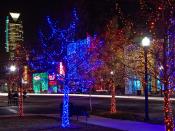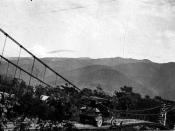An automated delivery system allows for a package to travel from one point to another, only involving humans when the destination is specified. One suggested method is that of an underground system on which packages are transferred using cables and a specialized carrier that would travel on the cables. However, the problems of cost and infrastructure make this a somewhat difficult option. Assuming the existence of computer controlled cars, one can arrive at a somewhat easier solution: using computer controlled cars to deliver packages and goods.
A computer controlled car could be loaded with a package and instructed to deliver it to another location and then left to its own devices to make the delivery. Several issues must be dealt with before this becomes practical or useful.
First, a computer controlled delivery car should save time over conventional delivery methods. This can be attained using global positioning satellites and an online traffic monitoring system.
The car would already need the GPS to direct itself to its new location and it could use this to find alternate routes should one be reported as jammed. The cars could be a part of an online network which would report traffic problems as they arise allowing for up to the minute rerouting of deliveries. Local radio traffic reports could also be sent to the network and used as well.
Second, a computer controlled delivery car must be affordable enough such that the average consumer can buy and maintain one. This can be attained due to two factors: first, a car that is designed specifically to shuttle packages can be built far smaller than those built for people. Since the car would only hold packages, concerns such as passenger safety devices would not be necessary, nor would the amenities normally found in a car. In theory, the car could be about as large as a common desk and could run farther due to its lighter weight. The lighter weight would allow the car to use a smaller engine, making the car more energy efficient and allowing it to run using less fuel. This lightness also opens up the possibility of an electric model that would burn no fuel and still have enough range to make a day's worth of deliveries, making it more environmentally safe. The second factor affecting cost is one of mass production. If these cars are produced on a large scale, the prices should be dropped down to a point where they would cost as much as a personal computer.
Lastly, a computer controlled delivery car must be able to complete the delivery. Currently, when a package is delivered, the truck driver carries it some distance to a point where he leaves it. This can be as simple as placing it at a unloading station or as difficult as carrying packages up into apartment or office buildings. This is another area where the smaller size of a computer controlled car would be a distinct advantage. The cars would be small enough to drive right up to somebody's doorstep or enter apartment or office buildings and deliver the packages right to the door.
What would this take: First, one must apply all of the technology needed to run a computer controlled car. However, there would be a few other pieces of technology which would be necessary. First is an online network and database to which all of the delivery cars have access. This network would maintain traffic information as well as report difficulties in delivery such as car malfunction or human error (a human driver crashes into a delivery car). This network could also be used to add features to the delivery service. For example, a customer might specify a particular spot for all future deliveries, something that could be used by a different car at a later time. For security reasons, the database could keep track of customer signatures or fingerprints so that valuable packages are delivered only to the people who ordered them. This technology is largely available now and would only take the time and effort to design a system that is safe and effective.
Another item for which the technology is already available is an automated phone system which could call the customer if there are problems in delivery. For example if students in a dormitory order a pizza and the car is locked out of the dorm, the car could call the students to let it in.
The car would also have to be able to open doors and navigate through crowded areas, finding an elevator in multi-story buildings. This would require some extra programming and possibly some kind of robotic hand or implement to manipulate doors and elevator buttons. Delivery cars moving among people in buildings could cause problems and some buildings may even want to build a special delivery entrance and elevator to keep the cars from getting in the way of the people inside however, this is not necessary.
There are a few limitations to this system however. The delivery car would have to be limited to short range deliveries for it to be practical. The packages would be limited to the size of the space in the car as well. This system would also add more traffic to already crowded streets because instead of having multiple packages delivered to different destinations on the same truck, there would be a car for each destination. However, these limitations are acceptable in light of the advantages of the system.
This system would pose numerous advantages over a cable suspended system and the current delivery system. It would be cheaper, faster, and require less manpower than conventional delivery systems. It could also go places that a cable run system could not and would not pose the problems of cost and maintenance of a utility.
This system is not without its societal consequences however. Thousands of delivery workers would lose jobs. This would also revolutionize the delivery industry, forcing large companies like UPS and Federal Express to change their strategies. They could however incorporate the delivery cars into their current system, using conventional methods to deliver the packages from city to city and using the delivery cars to deliver the packages to their final destination and pick up packages to be delivered. The greatest change however would be in the way society purchases items. Food could be ordered and delivered in time for dinner, revolutionizing that industry. Other items also could be delivered, eliminating the hassle of driving and purchasing the items (such as toiletries or other consumables). Although the system might meet some resistance from people set in their current ways, eventually it would be generally accepted become as commonplace as our current delivery system.





